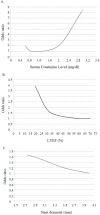A Risk-Scoring Model to Predict One-year Major Adverse Cardiac Events after Percutaneous Coronary Intervention
- PMID: 26985204
- PMCID: PMC4791644
A Risk-Scoring Model to Predict One-year Major Adverse Cardiac Events after Percutaneous Coronary Intervention
Abstract
Background: The aim of the present study was to develop a scoring system for predicting 1-year major adverse cardiac events (MACE), including mortality, target vessel or target lesion revascularization, coronary artery bypass graft surgery, and non-fatal myocardial infarction after percutaneous coronary intervention (PCI).
Methods: The data were extracted from a single center PCI registry. The score was created based on the clinical, procedural, and laboratory characteristics of 8206 patients who underwent PCI between April 2004 and October 2009. Consecutive patients undergoing PCI between November 2009 and February 2011 (n= 2875) were included as a validation data set.
Results: Diabetes mellitus, increase in the creatinine level, decrease in the left ventricular ejection fraction, presentation with the acute coronary syndrome, number of diseased vessels, primary PCI, PCI on the left anterior descending artery and saphenous vein graft, and stent type and diameter were identified as the predictors of the outcome and used to develop the score (R² = 0.795). The models had adequate goodness of fit (Hosmer-Lemeshow statistic; p value = 0.601) and acceptable ability of discrimination (c-statistics = 0.63). The score categorized the individual patients as low-, moderate-, and high-risk for the occurrence of MACE. The validation of the model indicated a good agreement between the observed and expected risks.
Conclusion: An individual risk-scoring system based on both clinical and procedural variables can be used conveniently to predict 1-year MACE after PCI. Risk classification based on this score can assist physicians in decision-making and postprocedural health care.
Keywords: Patient-specific modeling; Percutaneous coronary intervention; Prognosis.
Figures
References
-
- Weintraub W, Grau-Sepulveda M, Weiss J, Delong E, Peterson E, O'Brien S, Kolm P, Klein L, Shaw R, McKay C. Prediction of long-term mortality after percutaneous coronary intervention in older adults: results from the National Cardiovascular Data Registry. Circulation. 2012;125:1501–1510. - PMC - PubMed
-
- Shaw RE, Anderson HV, Brindis RG, Krone RJ, Klein LW, McKay CR, Block PC, Shaw LJ, Hewitt K, Weintraub WS. Development of a risk adjustment mortality model using the American College of Cardiology–National Cardiovascular Data Registry (ACC–NCDR) experience: 1998–2000. J Am Coll Cardiol. 2002;39:1104–1112. - PubMed
-
- Peterson ED, Dai D, DeLong ER, Brennan JM, Singh M, Rao SV, Shaw RE, Roe MT, Ho KK, Klein LW, Krone RJ, Weintraub WS, Brindis RG, Rumsfeld JS, Spertus JA. NCDR Registry Participants. Contemporary mortality risk prediction for percutaneous coronary intervention: results from 588,398 procedures in the National Cardiovascular Data Registry. J Am Coll Cardiol. 2010;55:1923–1932. - PMC - PubMed
-
- Singh M, Rihal CS, Lennon RJ, Garratt KN, Holmes DR Jr. A critical appraisal of current models of risk stratification for percutaneous coronary interventions. Am Heart J. 2005;149:753–760. - PubMed
-
- Ellis SG, Weintraub W, Holmes D, Shaw R, Block PC, King SB, 3rd Relation of operator volume and experience to procedural outcome of percutaneous coronary revascularization at hospitals with high interventional volumes. Circulation. 1997;95:2479–2484. - PubMed
LinkOut - more resources
Full Text Sources
Miscellaneous


